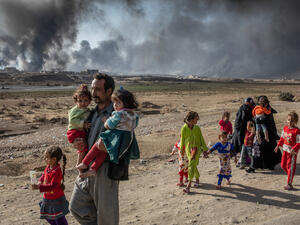2002 Statistics summary
2002 Statistics summary
At the beginning of 2003, the global number of refugees was estimated at some 10.3 million persons, a decrease of 1.7 million persons, or 14 per cent, compared to one year earlier. The main reason for the fall in the annual refugee population was the repatriation of almost 2 million Afghan refugees from Pakistan (1.6 million) and the Islamic Republic of Iran (380,000). Moreover, some 88,000 Angolan refugees returned home during the year as well as 76,000 refugees from Sierra Leone, 53,000 Burundi refugees, 37,000 refugees from Bosnia and Herzegovina, 32,000 Somali refugees as well as 32,000 refugees from Timor-Leste. In all, an estimated 2.4 million refugees returned home during 2002, one million more, or 70 per cent, than the average annual number of refugees who repatriated during the past ten years (1.4 million).
In 2002, some 19,600 refugees found a solution to their plight through resettlement under UNHCR auspices, a fall of 44 per cent compared to 2001, when 34,700 refugees were resettled. The main reason for this fall in annual departures is the decline in resettlement to the United States, which fell from 18,300 in 2001 to 8,100 in 2002 (-56%), as a result of enhanced immigration screening requirements.
Whereas many refugees were able to return home, almost 300,000 refugees became newly displaced in 2002. The main new mass outflows concerned refugees fleeing Liberia (105,000), DR Congo (39,000), Burundi (29,000), Somalia (24,000) , Côte d'Ivoire (22,000) and Central African Republic (20,000). Nevertheless, the annual number of mass refugee outflows in 2002 (293,000) was 41 per cent lower than in 2001 (496,000).
Despite the return of almost 2 million Afghan refugees, Asia continues to host the largest refugee population (4.2 million), although its share in the global number of refugees fell from 48 to 40 per cent. Africa hosts the second largest refugee population (3.3 million), followed by Europe (2.2. million), North America (610,000), Oceania (65,000) and Latin America and the Caribbean (41,000).
In 37, mostly industrialized, countries, located in Europe, North America, Asia and Oceania, some 587,400 asylum applications were submitted in 2002, 5 per cent fewer than in 2001 when 621,100 claims were lodged . In Europe, the annual number of asylum applications fell by 2.5 per cent to 465,600, whereas in the 15 countries of the European Union some 381,600 new asylum claims were registered (-1.7%).
As in 2001, the United Kingdom received the largest number of asylum claims (110,700), followed by the United States (81,100) and Germany (71,100). However, compared with the size of the total national population, Austria received the highest number of asylum applications in 2002 (4.6 per 1,000 inhabitants), followed by Norway (3.9) and Sweden (3.7).
Iraqi nationals formed the largest group of asylum-seekers in 2002, lodging some 51,000 new asylum applications in the 37 countries. The second largest group of asylum claimants consisted of citizens from Serbia and Montenegro (33,100), followed by Turkish asylum-seekers (29,600). The annual number of Afghan asylum-seekers fell by 51 per cent, from 52,800 in 2001 to 25,700 in 2002. As a result, Afghanistan, which had been the leading country of origin of asylum-seekers in 2001, ranked only fifth in 200
During 2002, more than one million internally displaced persons out of the 5.0 million considered of concern to UNHCR at the beginning of 2002 returned home during the year. A significant number of IDPs returned to their homes in Afghanistan (750,000), Sri Lanka (236,000), Bosnia and Herzegovina (71,000) and Russian Federation (59,000). At the same time, however, a sharp increase in internal displacement was reported for Colombia (230,000), Afghanistan (84,000) and Liberia (43,000). Moreover, some 100,000 citizens from Côte d'Ivoire became displaced during the year.
The total population of concern to UNHCR, including refugees, asylum-seekers, IDPs as well as those who returned during the year, increased slightly, from 19.8 million in early 2002 to some 20. 5 million in early 2003 (see Figure 3). This slight rise in the population of concern is the result of a combination of demographic, legal and administrative factors in more than 150 countries, including natural increase, new arrivals of refugees and IDPs, returns as well as adjustments to the refugee population on the basis of new registration and estimates. The significant returns of refugees and internally displaced during 2002, which continued to be counted as returnees in 2002, will have a significant impact on the population of concern as of early 2004.









